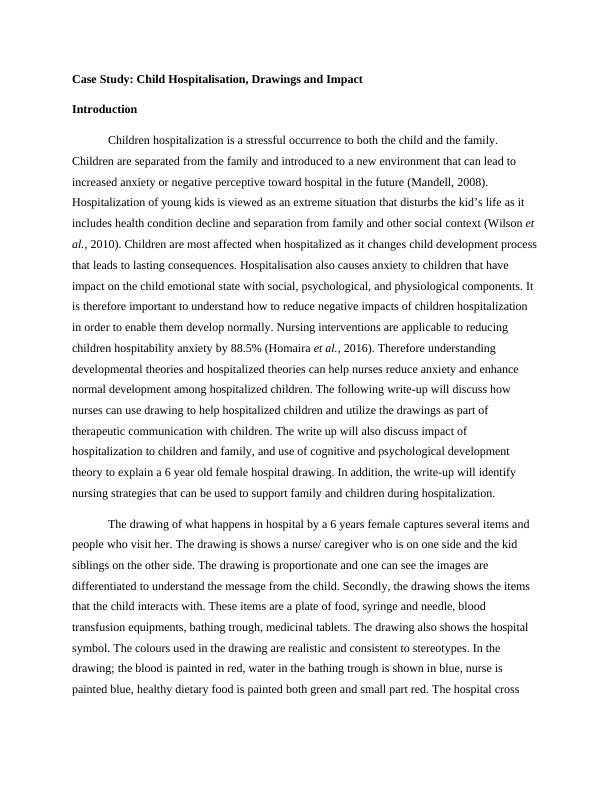Impact of Hospitalization to Children and Family
Added on 2021-04-21
10 Pages3025 Words472 Views
UNIT:NAME:DATE:

Case Study: Child Hospitalisation, Drawings and Impact IntroductionChildren hospitalization is a stressful occurrence to both the child and the family. Children are separated from the family and introduced to a new environment that can lead to increased anxiety or negative perceptive toward hospital in the future (Mandell, 2008). Hospitalization of young kids is viewed as an extreme situation that disturbs the kid’s life as it includes health condition decline and separation from family and other social context (Wilson et al., 2010). Children are most affected when hospitalized as it changes child development processthat leads to lasting consequences. Hospitalisation also causes anxiety to children that have impact on the child emotional state with social, psychological, and physiological components. It is therefore important to understand how to reduce negative impacts of children hospitalization in order to enable them develop normally. Nursing interventions are applicable to reducing children hospitability anxiety by 88.5% (Homaira et al., 2016). Therefore understanding developmental theories and hospitalized theories can help nurses reduce anxiety and enhance normal development among hospitalized children. The following write-up will discuss how nurses can use drawing to help hospitalized children and utilize the drawings as part of therapeutic communication with children. The write up will also discuss impact of hospitalization to children and family, and use of cognitive and psychological development theory to explain a 6 year old female hospital drawing. In addition, the write-up will identify nursing strategies that can be used to support family and children during hospitalization.The drawing of what happens in hospital by a 6 years female captures several items and people who visit her. The drawing is shows a nurse/ caregiver who is on one side and the kid siblings on the other side. The drawing is proportionate and one can see the images are differentiated to understand the message from the child. Secondly, the drawing shows the items that the child interacts with. These items are a plate of food, syringe and needle, blood transfusion equipments, bathing trough, medicinal tablets. The drawing also shows the hospital symbol. The colours used in the drawing are realistic and consistent to stereotypes. In the drawing; the blood is painted in red, water in the bathing trough is shown in blue, nurse is painted blue, healthy dietary food is painted both green and small part red. The hospital cross

symbol is also painted in red. The people in the drawing are drawn in the same way or differentiated by colour to differentiate between the caregiver and her visitors. Items in the drawingColoursA plate with foodSyringe with needleHospital symbolMedication TabletsBlood infusion SetBloodBathing trough Siblings Prescription cardGreenRedDark redBlueYelloworangeDrawing is an important tool to a hospitalized child. Drawing help hospitalized children to express themselves. First, drawing helps the children to express their inner desires and feelings(Drake and Winner, 2013). The child is able to communicate their inner desires. For instance, children are able to express their desired state of their room or environment. The children are also able to express their feelings that review their worrying issues. Drawing enables children to focus on their inner self and present their feeling that indicates their emotional status. Secondly, drawing helps hospitalized children to express their perceptions and observations about the issues they are facing. Drawing enables children to express traumatic memories experienced and thoughts about themselves and the environment (Li, Chung and Ho, 2011). Thirdly, drawing enables children to express their personality, intelligence, and development progress. The

End of preview
Want to access all the pages? Upload your documents or become a member.
